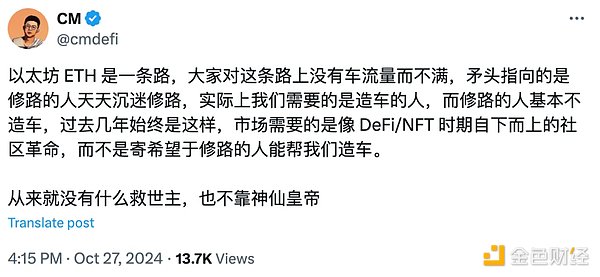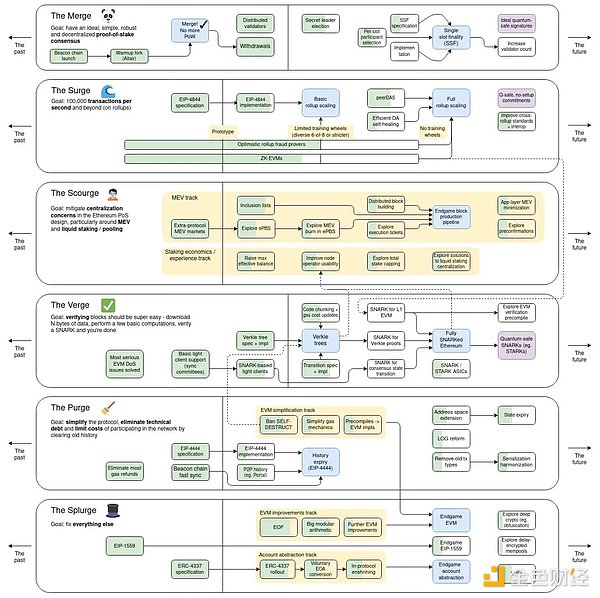Author: cryptoHowe.eth Source: X, @weihaoming
Recently, due to a tweet by @jason_chen998, there has been a lot of discussion about Ethereum. After reading the views of @tmel0211, @cmdefi and others, I also want to share my own views and opinions. If there are any problems, please feel free to point them out.

Mr. Chen used the examples of car manufacturing and road construction. I will use another possibly inappropriate example to illustrate. Here, we will compare the Ethereum ecosystem to a real estate development that can be speculated on, with retail investors being those who want to speculate on the property, and the Ethereum Foundation being the developer/property management.
Looking back at the development of the Ethereum ecosystem, we can find that the construction route and process of the development are basically determined and executed by the developer. In the early stages of the development, this did not have much impact, as it was originally an empty lot, and the most important thing was to first build the development, get it on the market, and start delivering it, so as to start attracting investors and investment.

The current Ethereum ecosystem is similar to a development that has been delivered for a certain period of time, and has also experienced several good investment booms, and the Ethereum Foundation has also begun to take on the role of property management. By now, I believe most of us have experienced scenarios where there are disagreements and conflicts between property owners (investors) and property management. Currently, the disagreement is between what the property management (the Ethereum Foundation's decisions) is doing and meeting the needs of the property owners (the market users'), just like the property owner reporting to the property management that the drainage pipe in their home is clogged, and the property management takes a few days to come up with a plan to dismantle and replace the drainage pipes in all the buildings. This is in line with what Mr. Meng Yan @myanTokenGeek said last night in the Space, that the Ethereum Foundation's current approach tends to be pursuing the best, rather than just good enough.
But as I've always said, what users care most about when using a product is whether they can simply and quickly meet their own needs. They don't care whether the product they're using is Web2 or Web3, and they don't care how much the product has improved compared to other products in certain aspects, they only care whether the product can simply and quickly realize their needs.
That is, the property owner just wants the property management to quickly unblock their drainage pipe, and doesn't care whether other property owners have the same problem or how much the property management spends to have someone else handle it. If the property management chooses to ignore the direct needs of the users and instead adopt a longer-term and more time-consuming solution, this will lead to serious dissatisfaction and even loss of property owners, and for external investors considering buying into the development, seeing this scenario, they may have some concerns about the appreciation potential of the development, and may even be attracted to the neighboring development with better service and greater potential.
Therefore, in the current ecosystem development, the Ethereum Foundation's approach is greatly disconnected from the needs of the market users. Users, after experiencing events such as the proliferation of Layer2 and the bloodsucking, and the prosperity of the neighboring Solana, inevitably express concerns about the "calm" phenomenon of Ethereum. And as one of the important roles in the development of Ethereum, the Ethereum Foundation undoubtedly needs to comprehensively consider both technical research and development and market needs, and blindly burying itself in technical research while ignoring the voice of the market will undoubtedly result in the rapid loss of a massive number of users.
My personal view is that I tend to hope that the Ethereum Foundation can find a suitable balance point between the development path and market needs, and not just find the optimal solution. Ethereum has already achieved so much, we can't just negate its achievements because of a momentary crisis. The key to what price a development can be sold at lies in whether the investors themselves can find good selling points, such as good decoration (complete infrastructure) and good supporting services (mature ecosystem), and these are not the things that the developer/property management needs to be most concerned about, their focus is more on ensuring the safety of the buildings and improving the quality of the services.
At the same time, we should not forget that if it were not for the efforts of the Ethereum Foundation, there would not be a solid infrastructure to support the thriving of the upper-layer applications, and their efforts are also worthy of recognition. Finally, I will end with a sentence.
Time and patience will be the best remedy.







